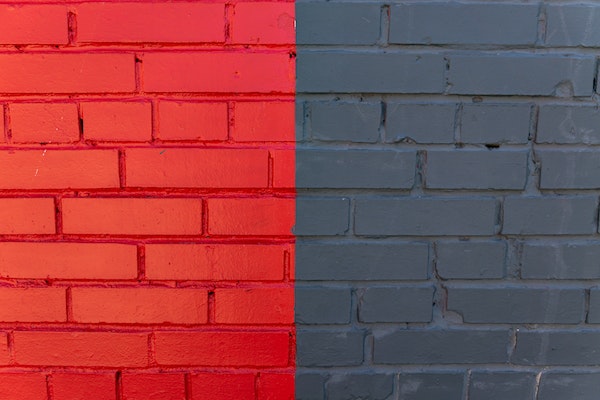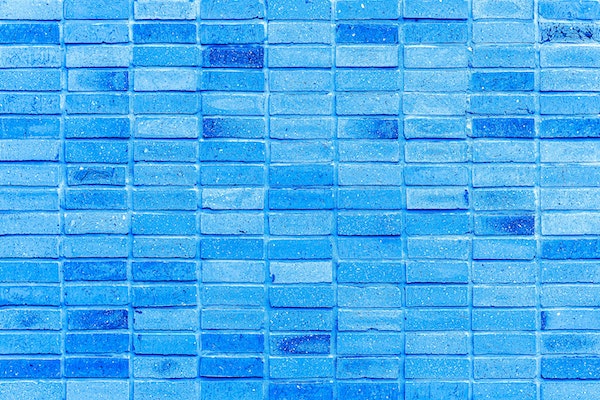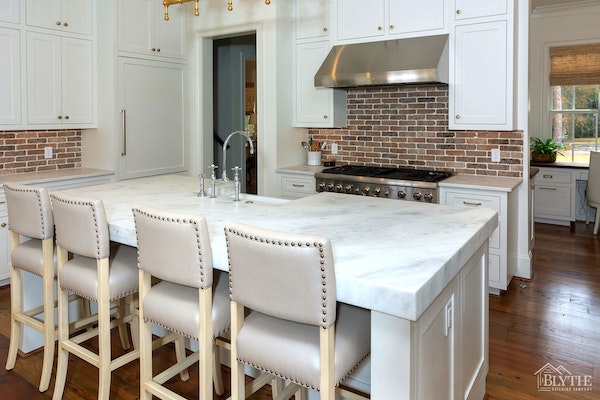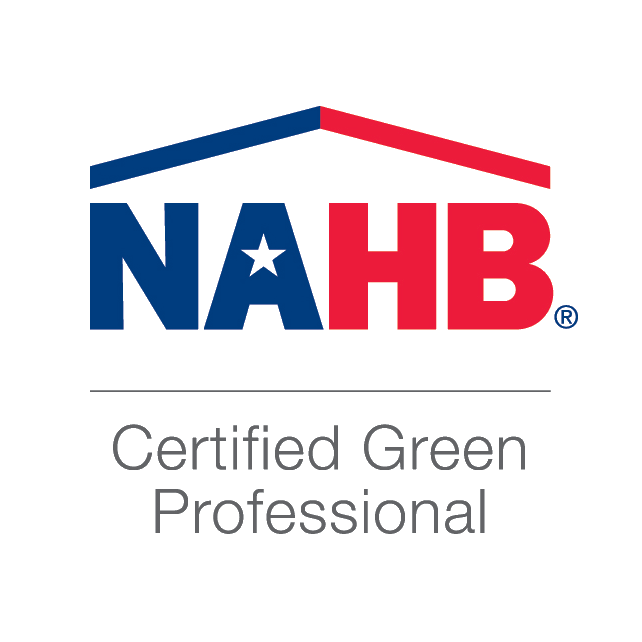A white painted brick house – Colonial Style luxury home in Columbia, SC
We have seen a lot of interest in exterior brick paint, messy mortar, German smear finishes for brick, mortar washes, and other specialized brick finishes from our clients in the South Carolina luxury home market recently.
People are interested in a Modern Farmhouse or Modern Craftsman look. Finishes that look distressed or “Old World” are popular, too.
Of course, we also build many homes with other exterior materials like bare brick, Hardie Board plank siding, and board and batten. Each of those finishes also has its own unique charm.
There is something about brick that draws people to it. The durability and strength. The texture. The warmth and the unique architectural aesthetic.
If you love your brick unpainted and “raw,” we’re here for that. But if you want to explore the possibilities of painted brick, or paint alternatives for brick, we’d love to help you discover your options there, too.

Is painting a brick house a good idea?
One of the greatest advantages of having a brick home is that you don’t need to paint it. You can choose a color you love and go with bare brick so you have low maintenance and timeless beauty.
But maybe you’d like a different vibe for your dream home and can’t help but ask yourself, “Should I paint my brick house?”
We are happy to inform you that yes”
Brick can be painted.
And it can look amazing. The question really is a matter of preference.
When thinking about whether to paint brick, it’s good to have a handle on the advantages and disadvantages that come with painted brick vs. bare brick.
Pros and cons of painting exterior brick
Every building material decision comes with its pros and cons. Painted brick is no different.
Pros of painting a brick house
There are quite a few benefits to painting a brick home. Here are a few of the top reasons you should paint your brick home.
- Huge visual impact — Painting brick gives your house a whole new look and can even add to your home’s value by upping your curb appeal. It sets it apart from your neighbors’ homes and looks unique with a more uniform effect than unpainted brick. Painted brick, done well, looks very sophisticated and modern.
- Weather protection — Painted brick (using the right paint, preparation, and technique) can be better protected from water damage, fading, and the elements than unpainted brick.
- Easier to clean — With a smooth painted surface, rather than so many nooks and crannies of unpainted brick, it’s much easier to keep your home clean and beautiful. When the pine pollen coats everything in yellow, no problem. It’s easy to wash away in a snap.
- You’re not stuck with one color — Change the entire appearance of your home when you repaint by opting for a new color. If you prefer variety, this option may be very appealing.
- Creative opportunities — Most people who paint their brick homes use one color for all of the brick areas. But with paint, you have a lot more flexibility to make your own style statement. Use two contrasting but complementary colors to highlight certain architectural elements.
Cons of painting a brick house
There are some downsides to painting a brick house. It’s a good idea to consider them before you dive in.
- More maintenance may be required — Paint can need touching up, at times. Using the highest quality paint can help to greatly reduce the frequency of maintenance.
- More frequent power washing — Especially with lighter colors, paint allows dirt, mildew, and pine pollen to show up more noticeably. But the good news is that with the smoother painted surface, power washing is a lot faster than with unpainted brick.
- Paint is relatively permanent — Once you paint the entire home, it is hard to go back. You can repaint with a different color. And paint can potentially be stripped. But if you think you will want to go back to unpainted brick in the future, avoiding paint to start with may be best.
- Moisture could be a problem if you use the wrong paint — Natural brick can “breathe.” Painted brick can trap moisture inside if there is a problem beneath the surface of the walls and water is trapped from the inside. Using “breathable” paint can help to overcome this concern.

A white painted brick home – Craftsman style on Lake Murray, SC
What paint to use on exterior brick?
When painting exterior brick, we believe the best paint for brick is Sherwin Williams Loxon Masonry Topcoat for the top finish coats. It’s critical to use outdoor brick paint if you decide on painting the exterior of your brick house. (For other professional Luxon paint products, click here.)
There is nothing worse than painting your beautiful brick dream home with the wrong type of paint and having problems with peeling, moisture, or mold after your investment.
Loxon is engineered for providing high-performance protection for brick walls that are above grade. It blocks water to protect your masonry from moisture penetration, which keeps your home smelling fresh rather than damp and musty. We also love that it is available in a variety of colors.
The sheen is flat which helps to hide any surface imperfections. And this product is certified for low chemical emissions which makes it healthier for people to be around.
For technical notes on brick painting from The Brick Industry Association with specifics on what types of paint work best and how to properly prep brick walls for painting, click here.
How much does it cost to paint brick?
One gallon of Sherwin Williams Loxon Masonry Topcoat paint is $50.24 (check here for the most up-to-date price. Then, of course, there is the cost of labor for prep work and painting. Professional painters generally charge about $2.00-3.30+ per square foot for labor. Usually, one gallon of paint covers up to about 400 square feet for one coat.
For a 2500 square foot house, the average cost to paint a brick home is about $7000. But it can go up to over $10,000. Especially if you use top-of-the-line products. Prices can vary depending on which type of paint you buy, how complicated the job is, the size of your home, and labor pricing fluctuations in your area.

Rear exterior view of a large white painted brick home.
How long does painted brick last?
If you use high-quality paint that is suited for your climate, your paint job could potentially last more than a decade. (Talk with your contractor or painter about choosing paint that lasts longer if you’d like to skip frequent maintenance.)
The Brick Industry Association says to expect to repaint every three to five years. This would be especially true for lower-quality paints.
A key to having longer durability with your paint is proper preparation of the brick surface. The brick should be dry before being painted. And you never want to paint brick that is chipped, cracked, or in poor condition. Any problems should be corrected before applying the paint.
In South Carolina, mildew-resistant paint is important because of the high levels of humidity and rain we experience here. And UV-resistant paint is also crucial because we tend to get so many sunny days.

The best brick paint colors for your home
One advantage of painting your home is that you can update the color if color styles change. You aren’t stuck with one boring look for decades. Here are some of our suggestions for exterior brick paint color ideas.
White painted brick is the most popular color for painted brick, by far. It looks fresh and clean. And it won’t fade in the sunlight over time.
A dark-gray painted brick house can look stunningly dramatic. Just be sure your builder uses only premium paint with the highest quality pigments and UV protectants to prevent fading.
Greige, black, and navy blue are also popular colors for exterior brick. But if you choose dark exterior brick paint colors, keep in mind that the darker the colors, the more concerned you need to be about preventing fading.
An advantage of painted brick is that you can choose colors that you normally couldn’t find in brick options. Yes, you can go with white or other popular neutral colors. But you could also do a bold red or a dreamy teal. Or perhaps a sunny yellow.

The vast majority of painted brick homes are painted a uniform, solid color.
You can also create a unique look with different shades of color on different bricks, like in the image above with a mottled effect. (Depending on your HOA covenant, of course.)
Another popular way to use paint is to use two different complementary colors and use one for the majority of the brick and the other as an accent at the gables, for the dormers, or for the trim around the windows.
With paint comes great flexibility. You could even come up with a one-of-a-kind mural if you really wanted to. (Just don’t forget to think about your home’s resale value before you do something radically different. Consult with your builder or a trusted realtor for advice. And if you have an HOA, you may be limited to certain colors.)

Limewashed brick walls beside the fireplace
Alternatives to Painting Brick
Maybe you are interested in having some kind of effect on your brick but you don’t want to have to repaint your home. There are other ways to change the appearance of brick walls that may give you the look and level of maintenance you’ll love.
Limewash for brick
Limewash is a brick treatment that uses specially prepared powdered limestone and water. It has a similar effect to whitewash. But it is not paint. It is more of a putty that’s thinned with water and has a very chalky texture.
Centuries ago, it was used to protect buildings from weather including rain, wind, and UV light. It’s useful on any porous material like brick, cinder block, adobe, and even terra cotta).
Today, people love limewash because you can get an aged effect that adds a lot of character to their homes. It’s also widely used for historical renovation projects. It comes in white, gray, brown, and taupe. It does help to protect your brick from weathering. And it is resistant to odor, moisture, fungus, and insects.
The disadvantages of limewash are that the color can be different from what you expect. So it’s best to test the color before committing to it.
Mortar wash/German smear for brick
Mortar wash (also called German smear or German schmear) is a method of applying extra mortar on your brick and wiping some off of it before it dries. It creates an antique look. Usually, you’ll choose from a white or gray mortar.
The advantages of this look are that the materials are inexpensive and it adds beautiful old-world charm to a modern home. Also, you don’t have to reapply after several years like you would with paint.
The disadvantage of this look is that a mortar wash is a more time-consuming process than painting during application. Also, this effect, once applied, is essentially permanent. You would need muriatic acid to remove the extra mortar and it could be a difficult process.
Whitewash for brick
Whitewash is usually white latex paint diluted half and half with water and mixed thoroughly. You can adjust the ratio for a varied effect. The effect is smoother than that of a mortar wash.
Your brick can get a vintage look this way that adds a lot of depth and character to your home. The painter will wipe away some of the paint, which lets some of the original brick show through.
The advantages of whitewash are that it’s easy to apply and can last for up to 20-30 years with very little maintenance required.
The disadvantages of whitewash are that it only really comes in white. And that it is a rather permanent thing once it’s applied.
Brick stain
Brick stain is more difficult to apply to brick. It is more of a tint rather than a film. It goes deep into the brick and can change the color pretty dramatically. The end effect is that it looks like you have a totally different color of brick. Choose from colors like brown, orange, charcoal, dark plum, khaki, and more.
Stain is thinner (much more watery than paint) and often is sprayed on rather than rolled on. It may take more than two coats to get the look you are going for. And, unlike with paint, you can also still see the texture and raw beauty of the brick.
But the advantages are that staining lasts for a much longer time than paint. The Chicago Brick Company estimates that brick stain should last a minimum of twenty years. Stain is considered permanent. Basically, expect the color to be there until you apply a new stain or paint.

Can’t get enough brick? How about a custom thin brick backsplash.
Ready to Build a Custom Brick Home in Lexington, SC?
We have built over one-hundred homes in the Midlands area of South Carolina. Lee Blythe is also a Certified Master Builder who knows how to build the highest quality homes for clients.
If you’re ready to build your dream luxury home, we are here to help.
- Check out our work in our portfolio.
- And look over our building process to get a feel for what it’s like to work with us.
Contact us today to get started.
We build in areas like Chapin, Pine Ridge, Lexington, Lake Murray, Lake Carolina, downtown Columbia, West Columbia, Irmo, and more.
Related
What Is Board and Batten? Plus 7 Ways to Love It
Is a Brick Backsplash Right for Your Kitchen? Pros and Cons







